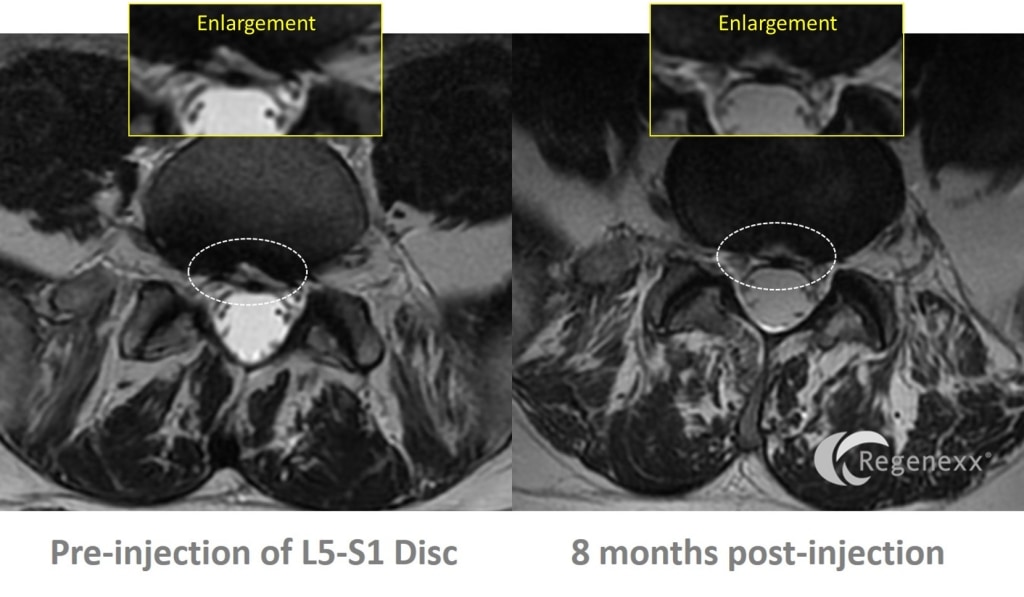Can a Disc Stem Cell Injection Work When All Else Fails?
RT is a 56 year old male with a very long history of back pain which began in the 70’s when he injured himself on a boat. He’s one of the more recalcitrant back pain patients that I have seen in years, failing to show significant improvements with just about everything we, or anyone else, did. That was until he got a disc stem cell injection, which seemed to be the only thing that’s been able to put a significant dent in his back pain.
At a young age this patient injured his back and found himself in the infirmary for a month. His pain eventually recovered to the point where every once in awhile he would have severe back pain episodes, but they would subside quickly. About 2008 these episodes began to take longer to go away, so he got a surgical opinion. He was told that he had disc annular tears and that there was no surgical treatment. Another surgeon told him that a low back fusion was the next step. Then in 2014 after long car trip he began to get L5 symptoms down his leg, so he signed up for an epidural, which helped a little. Activity after that would cause a his back to get side bent (a list). When I first saw him for an evaluation last summer, he was having 7/10 pain and despite being an avid cyclist, could only ride his bike 11-20 minutes. He had already tried SI joint injections and facet injections, but neither did him much good.
We first tried injecting platelet rich plasma and platelet growth factors around his irritated nerves and ligaments, but after several rounds of treatments that usually have a high success rate, we weren’t really getting anywhere. Given his sitting intolerance, his impressive MRI disc tear, and the fact that traditional injections that usually work weren’t helping, I agreed to try a disc stem cell procedure with Regenexx-SD. I injected his L5-S1 disc in December of 2014. As is common with disc injections, he was significantly flared up for 6-8 weeks or so, but then began to turn the corner. By April he was reporting 4/10 pain and much more importantly, much fewer days of severe pain. By July her reported:
“I’m feeling consistently around 60% of normal. I’m riding about 60 miles a week and swimming twice for about 40 minutes each. My back is always kind of tweaky and I can’t walk too much without pain, but am feeling so much better than I did a year ago.”
His before and after MRI is above. The MRIs were regrettably performed on different scanners, so we’re having the post injection image repeated on the same machine. However, the closest slice match between the two shows that the large tear in the back of the disc (white line in the dark disc blow up on the left) has gotten smaller (less white in the dark disc in the blow up on the right). These look like positive signs. The big question is whether we want to re-inject the disc a second time. In the meantime, we’ll go back to platelet growth factor epidurals to continue to reduce his pain, as there’s a good chance these will work now that the disc looks better (i.e. is no longer leaking bad chemicals onto the nerve or leaking less).
The upshot? It’s so good to see Rodger heading in the right direction. This was one of those times where the only thing that could help him was a disc stem cell injection, which is usually not the case for many patients we see. We may re-inject the disc, but in the meantime, at least he’s back to more of himself!

If you have questions or comments about this blog post, please email us at [email protected]
NOTE: This blog post provides general information to help the reader better understand regenerative medicine, musculoskeletal health, and related subjects. All content provided in this blog, website, or any linked materials, including text, graphics, images, patient profiles, outcomes, and information, are not intended and should not be considered or used as a substitute for medical advice, diagnosis, or treatment. Please always consult with a professional and certified healthcare provider to discuss if a treatment is right for you.
